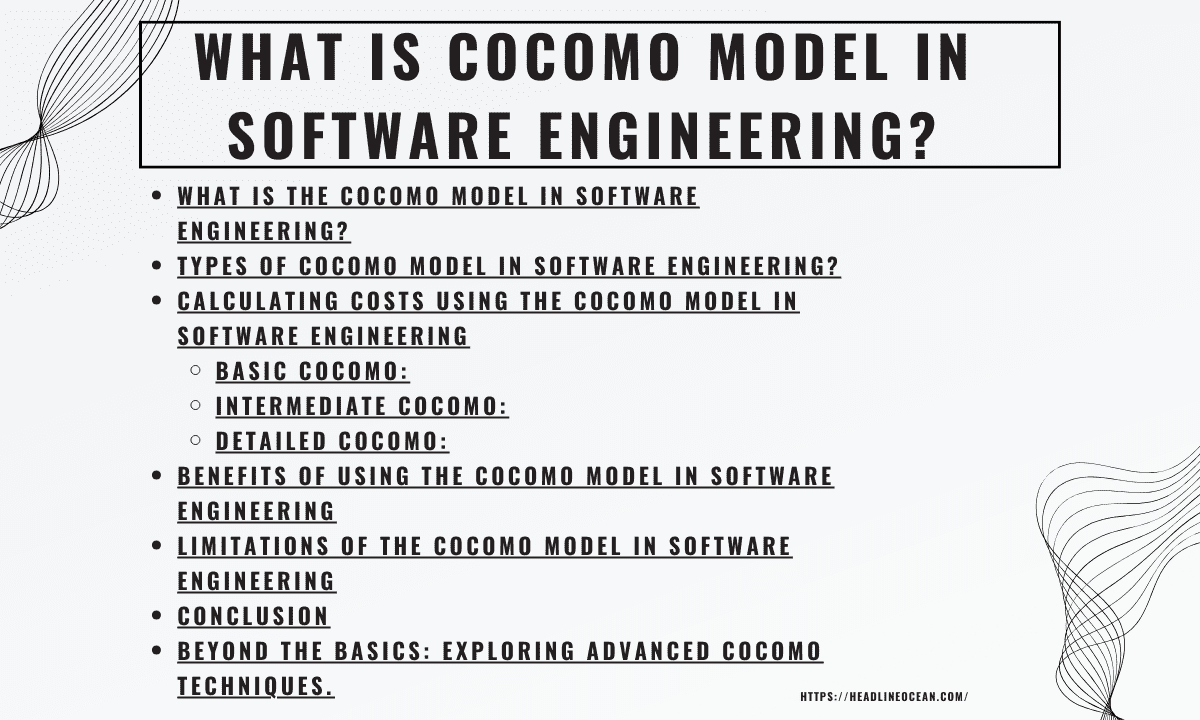Cocomo model in software engineering: In the constantly evolving field of software development, accurately estimating project expenses is critical to success. An underestimation might result in budget cuts and project delays, whilst an overestimation can render your project uncompetitive. This is where the COCOMO model in software engineering comes in.
What is the COCOMO Model in Software Engineering?
The COCOMO (Constructive Cost Model) is a well-known technique that estimates the effort (person-months) and cost of software development projects. The COCOMO model, developed by Barry Boehm in 1981, establishes a link between software project size (measured in Delivered Lines of Code (KLOC) and development effort.
Types of COCOMO Model in Software Engineering?
The COCOMO model in software engineering consists of three hierarchical tiers, each with increasing degrees of depth and complexity:
Basic COCOMO: This is the most basic level, ideal for tentative estimations. It calculates the development effort and timetable using a simple formula depending on the software’s size.
Intermediate COCOMO: This level offers a collection of cost drivers, which are variables that might impact the work necessary for a project. These cost drivers might be either beneficial (an experienced team) or negative (complicated needs). By taking these cost factors into account, the intermediate COCOMO model in software engineering delivers a more accurate cost estimate.
Detailed COCOMO: This is the most complete level, necessitating the division of the software project into smaller components. Each module is subsequently assessed using the COCOMO model in software engineering, taking into account its individual features and cost drivers. This level provides the most extensive and precise cost estimates.
Calculating Costs using the COCOMO Model in Software Engineering
Let’s look at how to calculate costs using the COCOMO model in software engineering. We’ll concentrate on the Basic COCOMO and Intermediate COCOMO techniques, which are the most often employed.
Basic COCOMO:
- Estimate Project Size: Determine the software project’s expected size in Delivered Lines of Code (KLOC). This can be done using historical data, user knowledge, or informed estimations.
- Apply the basic COCOMO formula: The basic COCOMO formula use the following equation to calculate effort (E) in person-months:
E = a(KLOC)^b
The variables ‘a’ and ‘b’ change according to the type of software project. The COCOMO model classifies projects into three categories: organic (a = 2.4, b = 0.05), semi-detached (a = 3.0, b = 0.07), and embedded (a = 3.7, b = 0.09). Project type selection takes into account elements such as originality, complexity, and development limitations.
- compute Development Time and Staff Requirements: Once you’ve estimated the effort, you can use another method to compute the development time (D) in months.
D = c(E)^d
‘c’ and ‘d’ are constants typically set to 0.33 and 0.41, respectively.
Finally, you can estimate the number of staff (P) required by dividing the effort by the development time:
P = E / D
Intermediate COCOMO:
The intermediate COCOMO model in software engineering extends the basic model by include cost drivers. These cost drivers are quantitative elements that might impact the amount of effort needed to construct the program. The COCOMO model finds 15 cost drivers, divided into seven categories:
- Product Factors: Reliability Required, Development Complexity, and Application Database Size.
- Computer factors include processing speed and main storage capacity.
- Personnel Factors: Analyst Capability and Application Experience
- Project Factors: Use of Modern Programming Practices and Schedule Constraints
- Product attributes: delivery flexibility, required reusability.
- Platform factors include familiarity with the operating system and virtual machines.
- Organizational factors include the quality of the work environment and developer motivation.
The COCOMO model in software engineering applies weighting factors to each cost driver. These weighting variables are then utilized to change the effort estimate calculated using the basic COCOMO procedure (using the same formula as basic COCOMO).
Detailed COCOMO:
- Break down your project into manageable parts (functional, component, or layered).
- Analyze each module Estimate the size (KLOC) and identify the key cost drivers (15 in COCOMO) for each module.
- Weigh the Cost Drivers. Assign a weighting factor (0–5) based on whether each driver has a positive or negative influence on the development effort of the relevant module.
- Calculate Adjusted Effort (by module): Use a formula that takes into account both the original effort estimate (based on size) and the weighted cost driver variables.
- Estimate the Development Time (per Module): To estimate development time in months, apply the COCOMO formula to the adjusted effort.
- Aggregate Project Values: Add the modified effort and development times from all modules to get the total project effort and development time.
- Calculate Cost: To calculate the entire development cost, multiply the whole project effort by the average cost per person-month (including salary and benefits).
In detailed COCOMO, you will use two basic formulas for calculating costs:
- Adjusted Effort (E’):
This algorithm takes the original effort estimate based on module size (KLOC) and modifies it for the influence of relevant cost factors.
E’ = E * Π(1 + CFj * Wi)
- E’: Adjusted effort for the given module (people-months)
- E: Estimate the initial effort depending on module size (KLOC) using the fundamental COCOMO algorithm (a * KLOC^b).
- Π: Multiplication of all relevant cost drivers (j) for the module.
- CFj: Cost driver weighting factor (0-5) for the jth cost driver (predefined in COCOMO).
- Wi: Weighting factor applied to the jth cost driver related to the module under analysis (depending on your judgment of its impact, generally 0-5).
- Development time (D):
This formula employs adjusted effort (E’) to estimate the module’s development time in months.
D = c(E’)d
- D: Development time for the module (months)
- E’: Adjusted effort for the module based on the first formula (person-months)
- c: Constant value is normally set to 0.33.
- d: Constant value is commonly set to 0.41.
Remember that detailed COCOMO requires project classification, cost driver evaluation, and, in certain cases, the use of judgment for factor weighting. It is a more difficult procedure than the basic or intermediate levels, but it yields the most accurate cost estimate.
Benefits of Using the COCOMO Model in Software Engineering
The COCOMO model in software engineering provides various benefits to software development projects:
- Improved Cost Estimation: By offering a systematic way to predicting effort and cost, the COCOMO model in software engineering assists in developing realistic project budgets and reducing cost overruns.
- Early Project Planning: The concept enables project managers to identify problematic cost drivers early on and address them proactively using mitigation methods.
- Increased Project openness: The COCOMO paradigm in software engineering encourages openness by providing a defined foundation for expense estimations. This improves communication and collaboration among development teams and stakeholders.
- Benchmarking: The model makes benchmarking easier by allowing software development companies to compare their project estimates to industry norms for comparable projects.
- Scalability: The COCOMO model in software engineering has three degrees of complexity, making it adaptable to projects of various sizes and complexities.
Limitations of the COCOMO Model in Software Engineering
While the COCOMO model in software engineering is a powerful tool, it’s important to recognize its limits.
- Accuracy: The model’s accuracy is strongly dependent on the accuracy of the initial size estimate (KLOC). Inaccurate size estimations might result in large cost differences.
- Project Specificity: The model may not be appropriate for all software projects, especially those utilizing new technologies or approaches.
- Cost Driver Subjectivity: Assigning weighting elements to cost drivers can be subjective, which may affect the final cost estimate.
Conclusion
The COCOMO model in software engineering is a foundation for predicting software development expenses. It offers a formal framework for analyzing the link between project size, effort, and cost. By applying the COCOMO model to software engineering, project managers may make more informed decisions, enhance project planning, and ultimately contribute to the success of software development projects.
Beyond the Basics: Exploring Advanced COCOMO Techniques.
While this essay focuses on the fundamentals of the COCOMO model in software engineering, experienced practitioners can employ more sophisticated strategies. This includes:
COCOMO II: An upgraded version of the original COCOMO model with a broader range of cost drivers and enhanced capabilities.
Cost Estimation via Analogy: Using past data from similar projects to estimate expenses for a new project.
Remember that while the COCOMO model is a useful tool in software engineering, it should not be used as the entire source of truth for predicting software development expenses. The COCOMO model must be combined with professional judgment, historical data, and a thorough grasp of the project’s unique requirements to produce the most accurate cost projections.
Project managers may obtain a competitive advantage and contribute to the success of software development projects by properly using the COCOMO model in software engineering.
If you like this “What is Cocomo model in software engineering?” article, please share it with your friends. For more updates, keep an eye on: www.headlineocean.com

